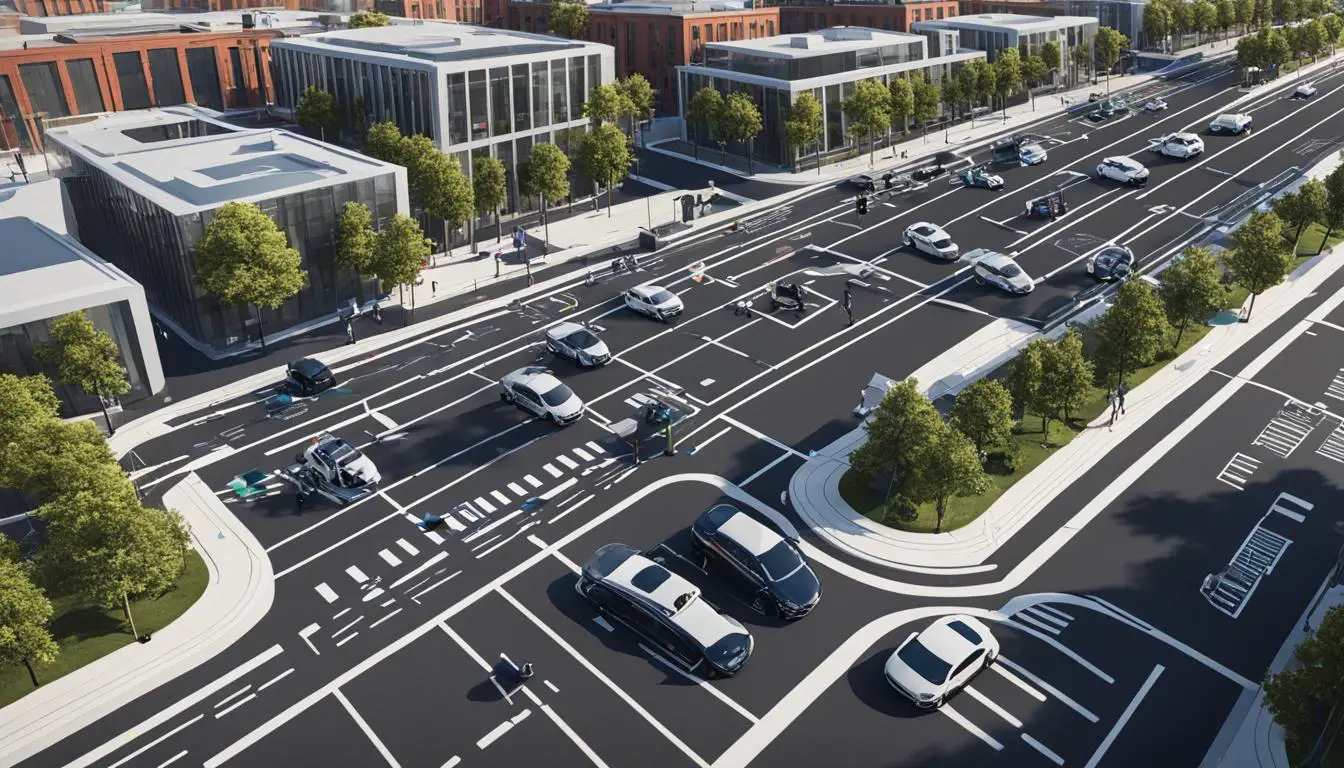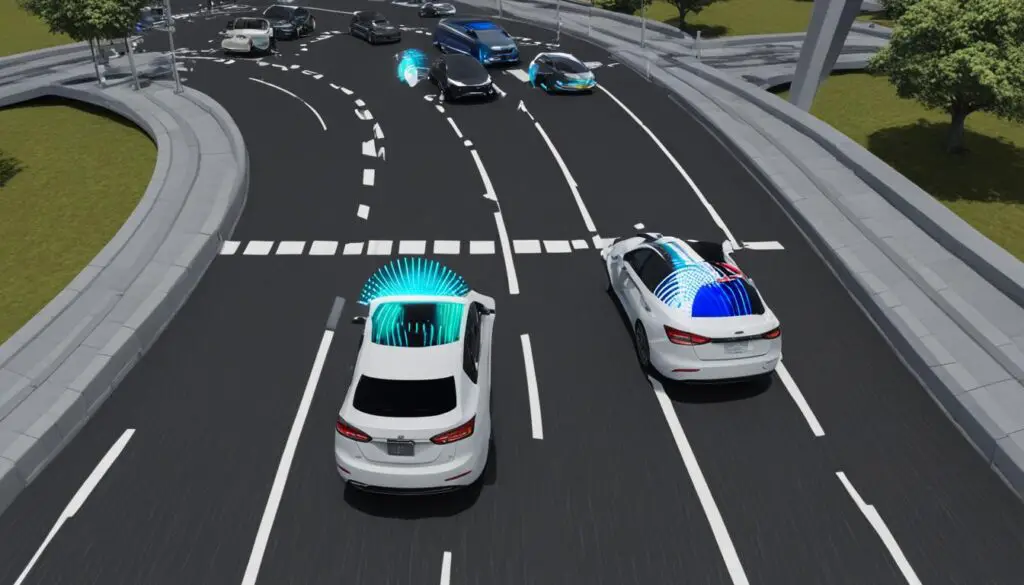
The Latest in Advanced Sensor Technology for Autonomous Cars
The advancements in autonomous car sensor technology have transformed the landscape of self-driving vehicles. The development of advanced sensor technology has paved the way for the growth of autonomous cars with features like emergency braking, collision avoidance, and adaptive cruise control.
According to industry forecasts, Level 3 autonomous vehicles will be commercially available by 2023, with a projected growth of 8 to 17 million advanced autonomous vehicles on the road by 2030. This exponential growth is a testament to the progress made in sensor technology.
Key Takeaways:
- Advancements in autonomous car sensor technology have enabled the development of self-driving vehicles.
- LiDAR and radar are the primary remote sensing technologies competing in this field.
- LiDAR offers high-resolution and accurate mapping capabilities, making it ideal for safety features.
- Radar provides a more cost-effective alternative and is catching up in terms of resolution.
- Sensor fusion, combining cameras, radar, and LiDAR, is the preferred approach for autonomous vehicle development.
How Advanced Remote Sensing Technologies Work
To support advanced driver assistance systems, autonomous vehicles rely on a combination of remote sensing technologies such as LiDAR and radar. LiDAR uses light to measure distances between objects and provides high-resolution, three-dimensional mapping, making it optimal for safety features like emergency braking and pedestrian detection. However, the high cost of LiDAR remains a challenge for mass adoption. On the other hand, radar is more affordable, performs well in various weather conditions, and has a wide field of view. It is commonly used for short- to medium-range applications like blind spot detection and adaptive cruise control.
The latest radar systems have closed the resolution gap with LiDAR and use MIMO antenna arrays for high-resolution mapping. In the future, a combination of cameras, radar, and LiDAR is expected to replicate the capabilities of LiDAR at a lower cost, making it a more accessible option for autonomous vehicles.
“LiDAR provides high-resolution, three-dimensional mapping, while radar is more affordable and performs well in various weather conditions.”
To illustrate the differences between LiDAR and radar, here’s a comparison table:
| Features | LiDAR | Radar |
|---|---|---|
| Measurement Principle | Uses light to measure distances | Uses radio waves to measure distances |
| Resolution | High-resolution, detailed mapping | Lower resolution, but improving |
| Cost | High cost | More affordable |
| Weather Performance | Affected by adverse weather conditions | Performs well in various weather conditions |
| Field of View | Narrow field of view | Wide field of view |
Note: The latest radar systems have closed the resolution gap with LiDAR and use MIMO antenna arrays for high-resolution mapping.
In the next section, I will explore how sensor fusion enhances the accuracy and redundancy of autonomous vehicle perception.
Sensor Fusion: Enhancing Accuracy and Redundancy
Sensor fusion plays a crucial role in enhancing the accuracy and redundancy of autonomous vehicle perception. By seamlessly integrating data from cameras, radar, LiDAR, and other sensors, sensor fusion provides a comprehensive and high-resolution representation of the vehicle’s environment.
This comprehensive perception enables autonomous vehicles to adapt and respond effectively to dynamic and challenging scenarios. With sensor fusion, the vehicle can process real-time information from multiple sensors and generate a comprehensive understanding of its surroundings, allowing for precise navigation and decision-making.
One of the significant advantages of sensor fusion is its ability to minimize erroneous detections and omissions. By combining data from multiple sensors, the fusion algorithm can cross-verify information and filter out false positives or negatives. This robust redundancy enhances the reliability and safety of autonomous systems, reducing the risk of accidents or mishaps due to sensor failures.
Furthermore, sensor fusion fortifies the system’s resilience in adverse weather conditions. Individual sensors may be affected by low light or inclement weather, compromising their accuracy and performance. However, by fusing data from multiple sensors, the system can compensate for these limitations, providing a more reliable perception of the environment.
The fusion of artistry and engineering in sensor fusion systems creates a harmonious collaboration that elevates autonomous driving to new frontiers of safety and reliability. By combining the strengths of different sensing technologies, sensor fusion empowers autonomous vehicles with comprehensive environment perception, enabling them to navigate complex scenarios confidently.
“Sensor fusion combines the best of multiple worlds, creating a unified perspective that enhances the accuracy and redundancy of autonomous vehicle perception.”

Advantages of Sensor Fusion:
- Provides a comprehensive and high-resolution representation of the vehicle’s environment
- Enables accurate perception and understanding of dynamic and challenging scenarios
- Minimizes erroneous detections and omissions through cross-verification
- Enhances system resilience in adverse weather conditions
The Future of Autonomous Driving in Extreme Weather Conditions
Autonomous driving technology aims to conquer the challenges posed by extreme weather conditions. With the integration of sensor fusion, autonomous vehicles can maintain awareness and navigate safely in adverse weather conditions, ensuring enhanced safety and efficiency.
Sensor fusion combines the data from various sensors, including cameras, radar, LiDAR, and others, to provide a comprehensive view of the environment. This integration overcomes the limitations of individual sensors, allowing the system to adapt and respond effectively to extreme weather conditions. By fusing data from multiple sensors, the system can compensate for factors like low visibility or heavy rain, ensuring continuous perception and accurate decision-making.
However, to fully conquer extreme weather conditions, seamless communication between vehicles and infrastructure is crucial. Vehicle-to-everything (V2X) communication enables real-time communication between vehicles, as well as between vehicles and nearby infrastructure. This interconnected network fosters coordinated movements and timely information exchange, enhancing safety and efficiency in extreme weather conditions.
An important aspect of V2X communication is its ability to provide relevant weather-related information to autonomous vehicles. For example, if there is a sudden snowstorm or a flooded road ahead, vehicles in the vicinity can receive instant alerts, allowing them to adjust their routes or driving behavior accordingly. This real-time information exchange further enhances the overall safety and efficiency of autonomous driving in extreme weather conditions.
“Extreme weather conditions pose significant challenges for autonomous driving. Sensor fusion and V2X communication play a crucial role in overcoming these challenges, ensuring enhanced safety and efficiency on the roads,” says John Anderson, an industry expert at Autonomous Solutions Inc.
Advantages of Sensor Fusion and V2X Communication in Extreme Weather Conditions:
- Improved perception: Sensor fusion provides a comprehensive view of the environment, minimizing the effects of low visibility and adverse weather conditions.
- Accurate decision-making: By integrating data from multiple sensors, autonomous vehicles can make precise and informed decisions, adapting to the rapidly changing road conditions.
- Enhanced safety: V2X communication enables the exchange of real-time weather-related information, allowing vehicles to proactively avoid hazardous situations.
- Optimized routes: With access to up-to-date weather and traffic information, autonomous vehicles can choose the most efficient and safe routes, avoiding areas prone to extreme weather conditions.
- Efficient navigation: V2X communication facilitates coordinated movements among vehicles, minimizing traffic congestion and optimizing the overall flow of traffic during extreme weather events.
With the integration of sensor fusion and V2X communication, the future of autonomous driving in extreme weather conditions looks promising. The continuous advancements in technology will further enhance the safety and efficiency of autonomous vehicles, making them better equipped to navigate through challenging scenarios with confidence.

| Advantages of Sensor Fusion | Advantages of V2X Communication |
|---|---|
| Enhanced perception in adverse weather conditions | Real-time weather updates and alerts |
| Improved accuracy and redundancy in sensor data | Timely traffic information for optimized route planning |
| Adaptability to changing road and weather conditions | Coordinated movements and better traffic flow |
| Minimization of erroneous detections and omissions | Proactive avoidance of hazardous situations |
Conclusion
The advancements in autonomous car sensor technology have propelled the future of self-driving cars into a new era. With the competition between LiDAR and radar as remote sensing technologies, we have witnessed the development of sensor fusion systems that integrate data from multiple sensors, paving the way for enhanced accuracy and redundancy in autonomous vehicles.
Sensor fusion acts as the driving force behind autonomous vehicles’ ability to comprehensively perceive their environment and effectively adapt to dynamic scenarios. Although LiDAR currently enjoys preference for safety features, the resolution capabilities of radar have significantly improved, poised to challenge LiDAR for market dominance.
Looking ahead, the future of autonomous driving in extreme weather conditions relies on the harmonious collaboration between sensor fusion and V2X communication. The continuous refinement and optimization of sensor fusion systems, coupled with seamless communication between vehicles and infrastructure, promise a future where safety, reliability, and unwavering determination converge in the realm of self-driving cars.
FAQ
What are the advancements in autonomous car sensors?
The advancements in autonomous car sensors have paved the way for the development of self-driving vehicles. These sensors use remote sensing technologies such as LiDAR and radar to provide accurate mapping and perception of the vehicle’s environment.
How do remote sensing technologies like LiDAR and radar work in autonomous vehicles?
LiDAR uses light to measure distances between objects and provides high-resolution, three-dimensional mapping, making it optimal for safety features like emergency braking and pedestrian detection. Radar, on the other hand, uses radio waves to detect objects and has a wide field of view, making it suitable for short- to medium-range applications like blind spot detection and adaptive cruise control.
What is sensor fusion and how does it enhance autonomous vehicle perception?
Sensor fusion is the integration of data from cameras, radar, LiDAR, and other sensors to provide a comprehensive and high-resolution representation of the vehicle’s environment. By combining data from multiple sensors, sensor fusion enhances the accuracy and redundancy of autonomous vehicle perception, enabling effective adaptation and response to dynamic scenarios.
How do autonomous vehicles navigate in extreme weather conditions?
Autonomous vehicles rely on sensor fusion to maintain awareness and navigate safely in adverse weather conditions. By integrating data from multiple sensors, including cameras, radar, and LiDAR, autonomous vehicles can overcome the limitations of individual sensors and adapt to challenging scenarios. Seamless communication between vehicles and infrastructure through V2X communication further enhances safety and efficiency in extreme weather conditions.
What is the future of autonomous driving and sensor technology?
The future of autonomous driving relies on the continuous refinement and optimization of sensor fusion systems, coupled with seamless communication. As advancements in sensor technology continue, there is potential for cost-effective alternatives to LiDAR, such as a combination of cameras and radar, to replicate the capabilities of LiDAR at a lower cost, making autonomous driving more accessible and reliable.
